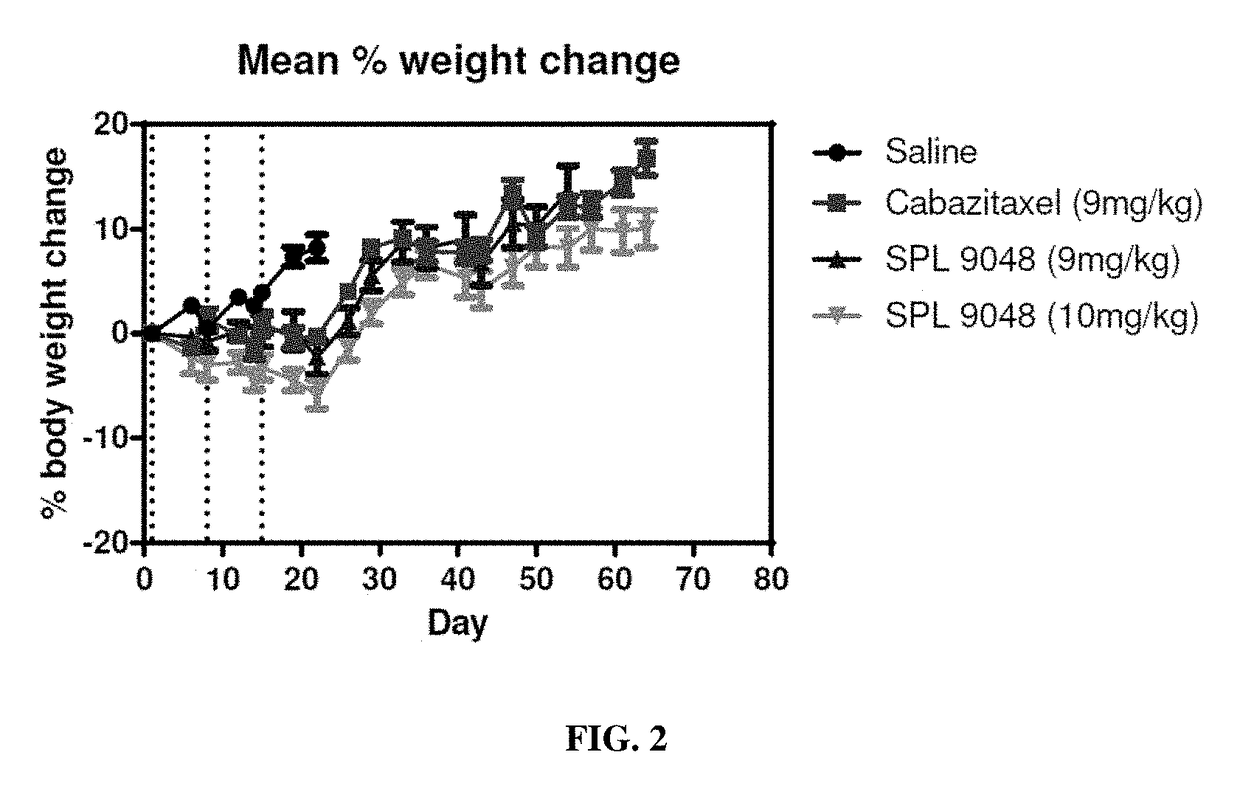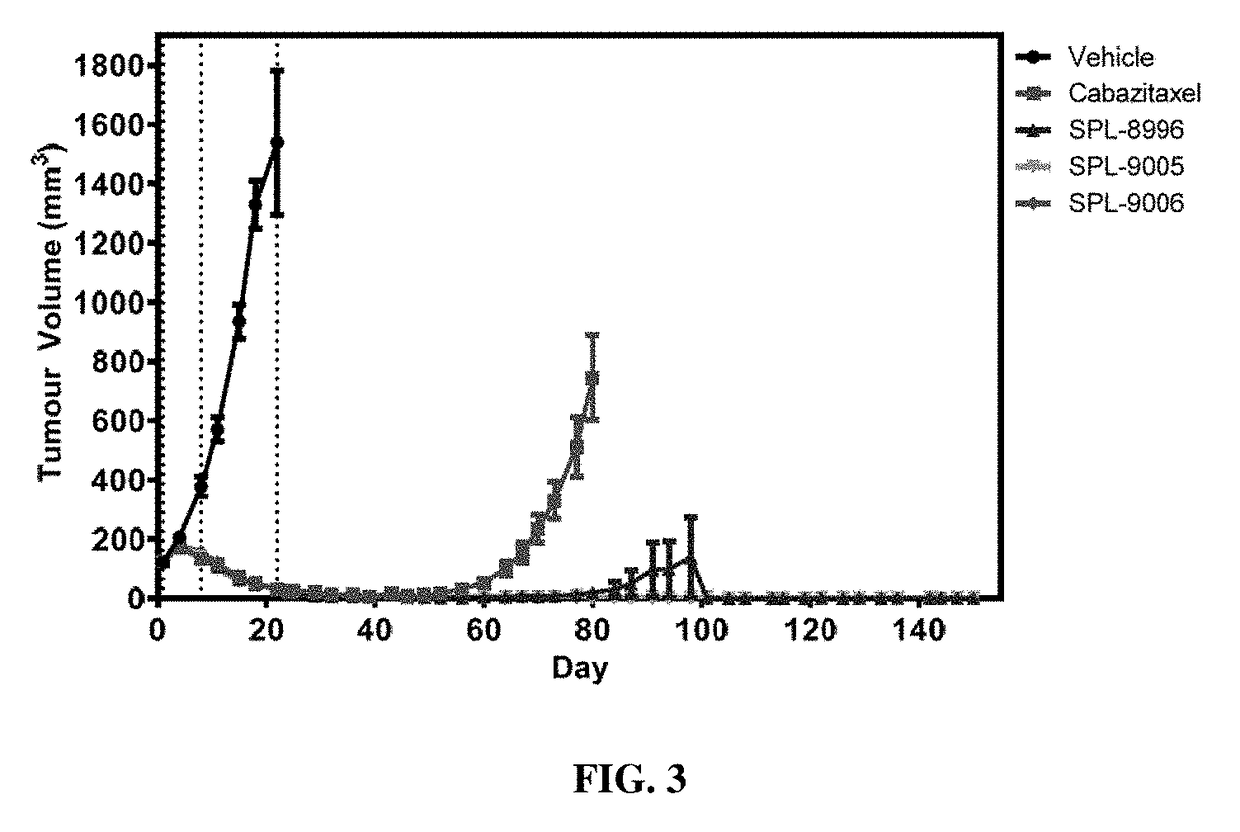Macromolecules
a micromolecule and molecule technology, applied in the field of micromolecules, can solve the problems of poor aqueous solubility, low bioavailability, lack of targeting to the site of action, etc., and achieve the effect of improving solubility and high drug loading
- Summary
- Abstract
- Description
- Claims
- Application Information
AI Technical Summary
Benefits of technology
Problems solved by technology
Method used
Image
Examples
example 1
(a) Preparation of 4-Aba-DTX
[0358]
[0359]Prepared using Procedure A above, using DTX (200 mg, 0.25 mmol) and 4-acetylbutyric acid (42 mg, 0.32 mmol) as the linker. Preparative HPLC (RT=32 mins) provided 73 mg (32%) of product as a white solid. LCMS (C8, gradient: 40-90% ACN / H2O (1-7 min), 90% ACN (7-9 min), 90-40% ACN (9-11 min), 40% ACN (11-15 min), 0.1% TFA) Rt (min)=7.60. ESI (+ve) observed [M+H]+=920. Calculated for C49H61NO16=919.40 Da. 1H NMR (300 MHz, CD3OD) δ (ppm): 1.09 (s, 3H), 1.13 (s, 3H), 1.38 (s, 9H), 1.66 (s, 3H), 1.74-1.97 (m, 7H), 2.10 (s, 3H), 2.12-2.36 (m, 1H), 2.29-2.58 (m, 8H), 3.83 (d, J=6.9 Hz, 1H), 4.14-4.26 (m, 3H), 4.95-5.05 (m, 2H), 5.18-5.35 (m, 3H), 5.61 (d, J=7.2 Hz, 1H), 6.05 (m, 1H), 7.17-7.20 (m, 1H), 7.23-7.45 (m, 4H), 7.52-7.62 (m, 2H), 7.63-7.72 (m, 1H), 8.10 (d, J=7.2 Hz, 2H).
(b) Preparation of BHALys[Lys]32[α-4-HSBA-4Aba-DTX]32[ε-PEG1100]32
[0360]
[0361]Prepared using Procedure C above. To a magnetically stirred solution of 4-Aba-DTX (15 mg, 16.3 μ...
example 2
(a) Preparation of PSSP-DTX
[0362]
[0363]In this example (R1═R2═H) it could be envisioned that the rate of release of docetaxel could be increased or decreased by increasing or decreasing the degree of steric hindrance about the disulphide bond (Worrell N. R., Cumber A. J., Parnell G. D., Mirza A., Forrester J. A., Ross W. C. J.: Effect of linkage variation on pharmacokinetics of ricin-A-chainantibody conjugates in normal rats. Anti-Cancer Drug Design 1, 179, 1986). This could be achieved through the addition of substituents, amongst others α and or β to the disulphide bond. This type of tuning strategy is often used in prodrug design strategies and takes advantage of the well known Thorpe-Ingold or gem-dimethyl effect (The gem-Dimethyl Effect Revisited Steven M. Bachrach, J. Org. Chem. 2008, 73, 2466-2468).
[0364]Prepared using Procedure A above, using DTX (500 mg, 0.62 mmol) and 3,3′-dithiopropanoic acid (130 mg, 0.62 mmol) as the linker. Preparative HPLC (RT=32 min) provided 179 mg ...
example 3
(a) Preparation of DGA-DTX
[0367]
[0368]Prepared using Procedure B above, using DTX (300 mg, 371 μmol) and diglycolic anhydride (86 mg, 742 μmol) as the linker. Preparative HPLC (RT=34 min) provided 85 mg (25%) of DGA-DTX as a white solid. LCMS (C8, gradient: 40-90% ACN / H2O (1-7 min), 90% ACN (7-9 min), 90-40% ACN (9-11 min), 40% ACN (11-15 min), 0.1% Formic acid) Rt (min)=5.90. ESI (+ve) observed [M+H]+=924.10. Calculated for C47H57NO18=923.36 Da. 1H NMR (300 MHz, CDCl3) δ (ppm): 1.11 (s, 3H), 1.21 (s, 3H), 1.33 (s, 9H), 1.58-2.66 (m, 7H), 1.73 (s, 3H), 1.93 (s, 3H), 2.67-3.67 (br s, 5H), 3.73-3.97 (br s, 1H), 4.02-4.68 (m, 7H), 4.96 (d, J=8.4 Hz, 1H), 5.24 (s, 1H), 5.35-5.55 (m, 1H), 5.50 (s, 1H), 5.66 (d, J=6.7 Hz, 1H), 5.95-6.30 (m, 1H), 7.24-7.68 (m, 7H), 8.08 (d, J=6.9 Hz, 2H).
(b) Preparation of BHALys[Lys]32[α-DGA-DTX]32[ε-PEG1100]32
[0369]
[0370]Prepared using Procedure C above, using BHALys[Lys]32[α-NH2.TFA]32[ε-PEG1100]32 (36 mg, 0.84 μmol) and DGA-DTX (30 mg, 33 mol). Purific...
PUM
| Property | Measurement | Unit |
|---|---|---|
| molecular weight | aaaaa | aaaaa |
| molecular weight | aaaaa | aaaaa |
| molecular weight | aaaaa | aaaaa |
Abstract
Description
Claims
Application Information
 Login to View More
Login to View More - R&D
- Intellectual Property
- Life Sciences
- Materials
- Tech Scout
- Unparalleled Data Quality
- Higher Quality Content
- 60% Fewer Hallucinations
Browse by: Latest US Patents, China's latest patents, Technical Efficacy Thesaurus, Application Domain, Technology Topic, Popular Technical Reports.
© 2025 PatSnap. All rights reserved.Legal|Privacy policy|Modern Slavery Act Transparency Statement|Sitemap|About US| Contact US: help@patsnap.com



